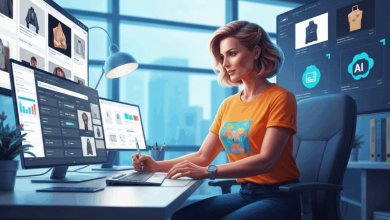AI-Powered Forex Brokers Are Quietly Reshaping the Forex Industry, How Far Will It Go?

Artificial Intelligence is slowly but surely changing how the forex world works. Now 92% of forex trades are automated by AI. Because it all seems simple and a new thing. But it’s not something new.
The automated trading systems were back in the 1980s. But now it has become much smarter.
Today, many modern forex brokers are now integrating Large Language Models (LLMs) such as GPT-4, Claude, Falcon, DeepSeek-R1, and FinTral into their systems. And these models help with tasks like client query automation, trade execution in natural language, and pattern recognition across market data.
This shift in AI has also opened discussions around the best AI tools for forex trading, especially for those looking to understand how automation shapes real-time decisions, as it can manage risks automatically which leads traders to spend less time guessing.
Such rapid adaptation raises an important question about where this growth is headed next.
The global AI trading market was worth $5 billion in 2023. At the same time, the forex market itself is set to grow by $582 billion between 2025 and 2029.
It all happened mainly because of the AI-powered platforms.
But the question is: Is it sustainable? Let’s research this today!
What is AI-Powered Forex Trading?
AI in forex trading simply means using intelligent computer systems to make smarter trading decisions.
These systems can think, learn from data, and react to market changes. Those tools are just like humans, only much faster and without emotions.
Here is what happened backstage,
Automotion tools study past and present market data to predict how prices might move. It can automatically place trades when the right conditions appear and adjust strategies to reduce risks. It is called Machine learning trading algorithms in AI language.
Some advanced systems even read news headlines or analyse social media sentiment to sense what’s driving the market.
Basically, AI works like a trading assistant.
Types Of AI In Forex Trading
AI is leaving so much impact on forex because it is a revolution. Each month or moment, there is someone making some tools. Some developers are working hard as hell to make trading experience easy.
So after a few months, traders will definitely hear about new AI tools added to the broker. But so far, there are-
| Type of AI in Forex Trading | Usage / Purpose |
| Automated Forex Trading Systems | Executes trades automatically based on pre-set rules and strategies, reducing human error. |
| Predictive Analytics in Forex | Analyzes historical market data to forecast future price movements and trends. |
| Algorithmic Trading Strategies | Uses coded algorithms to enter and exit trades at high speed for optimal profits. |
| Forex Market Prediction Models | The system builds mathematical and statistical models to predict currency pair behaviours. |
| Neural Networks for Forex Forecasting | Mimics human brain patterns to identify complex market trends and hidden correlations. |
| Artificial Intelligence Trading Bots | Forex bots that monitor markets 24/7, make trades, and manage portfolios automatically. |
| Deep Learning in Forex Trading | Processes massive datasets to detect subtle market signals and improve accuracy over time. |
| Data-Driven Trading Strategies | Relies on large-scale market data to shape decisions instead of emotions or intuition. |
| Forex Price Pattern Recognition | Identifies recurring patterns in charts to predict possible price reversals or breakouts. |
| Quantitative Trading with AI | Combines mathematical models with tools to make objective, data-based trading decisions. |
| Forex Signal Generation Using AI | Automatically produces buy/sell signals based on live market analysis. |
| Sentiment Analysis for Forex Markets | Scans news, forums, and social media to gauge trader sentiment and market direction. |
| AI Risk Management in Trading | The system identifies and controls potential risks by adjusting trade size or stop losses dynamically. |
| Backtesting AI Trading Models | Test trading strategies on past market data to see how they would have performed. |
| Real-Time Forex Data Processing | Processes live market data instantly to make faster, smarter trading decisions. |
How AI is Changing Forex Trading?
Around $6 trillion in trade happens daily. The numbers can’t be high if AI isn’t there helping out or shifting workload, right?
Modern forex brokers are now running on algorithms that think faster than humans ever could.
From trade execution to customer support, artificial intelligence is quietly and quickly. Here’s how it’s happening and just how far it’s gone.
The Speed & Execution Revolution
AI is super fast. So the task traders used to spend hours on. Now those tools can do it within the blink of an eye. For example-
GPT-4 and Claude-like tools are being used in client-facing chatbots that can interpret trading commands and explain complex financial terms. That’s a hassle and brainstorming time.
Meanwhile, FinTral and DeepSeek-R1 are great for financial time-series forecasting. It helps brokers predict currency pair movements and volatility shifts in real time.
Basically, these LLMs connect with broker trading engines via RESTful APIs or microservices. It is much faster and accurate.
Those tools give real-time data flow into transformer-based inference layers. So, the whole trading thing is easy from the broker & trader both sides.
It all can be done because of AI.
The systems can process and place thousands of trades per second. Those tools ensure traders get the best price possible.
This means traders can have less slippage and more accurate entries. Better timing when opening or closing trades
Also, traders will have access to multiple liquidity pools at once
Easy Of Data Collection
Data is a great deal in forex. Because understanding data makes or breaks the deal. That’s where AI helps them out.
Those tools can take in huge amounts of information, far beyond what any human could analyze.
Now traders don’t need to keep checked price charts or trend lines.
Tools can read through decades of historical data and connect it with what’s happening right now.
It can also go through live market feeds, breaking news, and even global events. Then make a move that actually benefits.
Here’s how the tool works to scrape data:
- It processes inflation reports, GDP numbers, and central bank announcements in seconds.
- predicting how they might move currency pairs.
- It spots patterns in price movements that most traders would overlook.
- Comparing real-time data with past trends.
Basically, AI doesn’t just collect data, it understands it.
It connects dots across time zones, economies, and behaviors to turn random numbers into meaningful trading insights.
To make all of this possible, brokers maintain real-time data pipelines built on technologies such as Kafka, Snowflake, and Databricks. These systems handle terabytes of tick data.
They stream it through cleaning and normalization stages, and feed it into feature stores that AI models can query in milliseconds.
Proper data labeling, bias correction, and low-latency processing are important.
Because even a small delay or inconsistency can distort model forecasts. That’s why brokers invest heavily in feature engineering and data pipelines. They even spend so much to monitor those.
Because they had to ensure trading algorithms receive clean, accurate market signals at all times.
So what used to be a huge brainstorming work.
Now it is nothing, just a few clicks.
Smarter Forecasting With Machine Learning
AI can predict markets now.
How does it do that?
Well, they can do it by using models like Artificial Neural Networks (ANN) and Support Vector Machines.
So, now trading platforms can forecast market direction, volatility, and the best entry or exit points.
As a result, traders get more informed, data-driven strategies that evolve with each trade.
Behind these predictions, brokers are adopting multi-agent orchestration frameworks such as LangChain and LlamaIndex.
Rather than one large AI model, brokers have now developed multiple agents. Each is made to help with a different task.
One for market sentiment, one for volatility forecasting & another for compliance monitoring.
These agents are connected through an internal orchestration layer that allows them to work in parallel, share signals, and execute faster with lower latency.
This modular setup improves accuracy. It also simplifies retraining, and gives brokers better transparency over model behavior.
Sentiment Analysis: Reading the Market’s Mood
Believe it or not, AI can actually “read the room” in forex trading.
It doesn’t just see numbers on a screen. It understands the story behind them. It can calculate the overall mood of traders. Also, figure out whether sentiment is leaning bullish or bearish.
Sounds surprising, right? Well, it is surprising. But it is true.
Those tools use NLP to make sense of human language to figure it out. This means it can interpret words, tone, and even subtle emotional cues in articles, tweets, forum posts, and press releases.
For example, if a central bank official hints at interest rate changes, those tools can pick up on the nuance and assess how the market might react.
Sometimes, even before charts start showing movement. So basically, it can save traders from a huge loss.
Underneath these advanced sentiment models, most AI-powered forex systems are built on a multi-layered technical architecture.
Typically, the process flows like this:
Market Data → Kafka Stream → Feature Store → ML Model (LSTM/Transformer) → LLM Orchestrator → Trade Execution Engine.
In simple terms, market data from various liquidity providers enters through Kafka streams, where it’s cleaned and processed in real time.
The data then moves to feature stores. Stores structured repositories that store curated indicators such as volatility metrics, sentiment scores, and liquidity depth.
Then machine learning models analyze these features to forecast market direction or price movement.
Finally, LLM orchestrators are powered by frameworks such as LangChain or LlamaIndex. Those tools interpret these outputs contextually and pass them to the trade execution engine. Then the tools places or adjusts trades instantly.
This orchestration layer allows brokers to maintain speed, scalability, and explainability across their AI systems.
All those steps ensuring every model output aligns with compliance, liquidity of the forex market, and risk constraints in real time. That’s why it’s easy to trade nowadays.
AI in Risk Management
If trading is about making smart moves, risk management is about staying alive.
Those tools take this seriously. It constantly scans volatility, adjusts stop losses, and predicts drawdowns before they happen.
It’s like having a full-time analyst watching over the account.
As AI becomes central to forex trading, brokers are also strengthening security and compliance frameworks. Since LLMs interact with sensitive market and client data.
So, they implement zero-trust access control and data encryption during model training.
Those models often made in isolated environments that comply with GDPR and local data residency regulations. Techniques like differential privacy and prompt filtering are applied to reduce risks of data leakage, model bias, or injection attacks.
That’s why those tools keep AI trading systems both secure and compliant.
AI will likely provide fully personalized trading experiences in the future. But it doesn’t mean it will replace human traders. It means the whole trading thing will be easy.
Maybe someday, traders just have to log into their account and see strategies ready for their risk level.
That’s even a match-up with the trader’s trading style and past performance.
It’s possible that maybe someday it could even adjust traders’ positions automatically if market conditions change. Basically, it will help protect traders’ funds without lifting a finger.
We may also see smarter predictive tools. It may combine market data with news and global events.
But the future isn’t about replacing traders. It’s about helping them.
Human insight, experience, and intuition will still matter. The best traders will use AI to handle repetitive tasks and data crunching.
So that traders will focus on strategy, big-picture decisions. Rather than being busy adapting to unexpected market events.
Basically, the forex trading world will be faster, more data-driven, and more automated.
The Bottom Line
If traders can use them wisely, those tools can help them trade faster, smarter, and more confidently. Used blindly, it can lead to overconfidence and costly mistakes.
AI is reshaping forex brokers for sure.
But the best traders are still the ones who know when to trust the machine… and when to trust themselves.
About the Author
- Nathan is a Business Development Executive at AssetsFX, with over 4 years of experience growing Forex partnerships across African and Asian markets. He now shares his insights and trending industry experience through writing on TopAsiaFX, helping readers understand the evolving world of Forex trading.

Source: AI-Powered Forex Brokers Are Quietly Reshaping the Forex Industry, How Far Will It Go?




